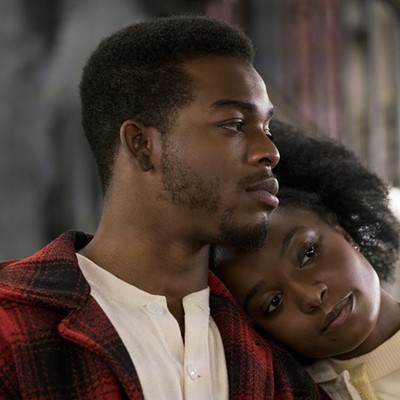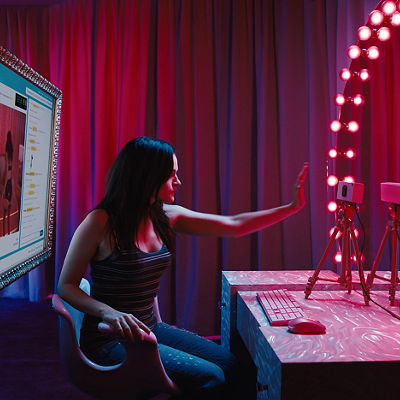What Altman does with narrative cinema is so delicate -- like weaving spider webs between blades of grass -- that there isn't much separating his moments of genius from his occasional botched scenes and subplots. More than one critic has compared him to a jazz composer, which also fits, but with one caveat: unlike most jazz composers, Altman doesn't take a melody, meaning a story, and improvise around it. Instead, he improvises from the get-go, and hopes that his knack for finding motifs and rhythms and resonant images will pull everything together into something coherent, maybe even indelible.
Unfortunately, Altman's latest movie, Ready to Wear (Pret-A-Porter), never quite comes together. Its missteps are so numerous, and so strongly rooted in Altman's basic conception, that there was probably no way it could have ever been shaped into something memorable. It's as shallow and monotonous and transparently crass as the world it purports to expose.
Set in the glamorous milieu of Paris fashion, the film assembles the standard-issue Altman elements: an ensemble cast of eccentric characters; a set of overlapping, interlocking subplots; and more satire of modern life than you can shake a can of glitter at. There are models and former models (Georgianna Robertson, Tara León, Ute Lemper), fashion magazine editors (Tracey Ullman, Linda Hunt, Sally Kellerman), journalists (Julia Roberts, Tim Robbins, Kim Basinger), photographers (Lili Taylor, Stephen Rea), designers (Richard E. Grant, Forest Whitaker, Anouk Aimee), and assorted businesspeople, government employees and hangers-on (among them Danny Aiello, Michel Blanc, Rupert Everett and Jean Rochefort), and they drift in and out of one another's lives like bits of confetti, plotting against each other, helping each other and getting in one another's way.
Altman sets the picture's tone with the opening credits sequence, which follows a mysterious Russian tailor (Marcello Mastroianni, whose function in this movie I was never quite sure of) from Russia to Paris. The director whooshes the camera around and around on a tripod so that the world becomes a colorful blur, and the names of the cast and crew, embroidered on bright scraps of fabric, drift up the screen.
But just when you think the director is setting you up for a lighthearted, whirlwind tour of an alien world whose inner workings we've all wondered about, he zaps you with satire, or what passes for satire these days: a close-up of a cast member's leg as he places one very expensive shoe right into a dollop of dog feces. The image is both extreme and uninformative; it cries, "Look out! Here I come to deglamorize a glamorous setting!"
That pretty much sums up Ready to Wear, both in terms of subject matter and approach. Altman creates a bunch of potentially interesting characters, places them in a complex and strange environment and cuts from subplot to subplot as if playing hopscotch. He's as dexterous as ever, and some of his individual characters and situations come off beautifully. (My favorites are Forest Whitaker's and Richard E. Grant's incandescently bitchy designer-lovers; Julia Roberts' and Tim Robbins' journalists who accidentally end up covering a big fashion news event from the same hotel room and, later, bed; and Kim Basinger's FAD-TV reporter, whose Texas twang and propensity to be shocked by human perversity makes her a credible audience surrogate.)
If the filmmaker had been content merely to chronicle the lives and loves of his standard-issue eccentrics, the film could have been frothy fun. But Altman just has to score points off these people. I'm not sure what he thought he was getting at by showing us that shoe landing in doggie mess, but you certainly couldn't call it sophisticated.
I'm also not sure why he takes such satisfaction in seeing so many of his characters ritually humiliated, often in public. The three fashion magazine editors, for instance, all fall under the charm of Stephen Rea's giggling Irish photographer, who finesses them into bed, takes photos of them undressing, giggling all the while like some idiot schoolboy -- and then files them away, presumably for blackmail use later on. Our sympathies are firmly with the women, who seem like decent, likable, classy professionals whose only crime is letting their emotional guards down, yet Altman treats them as dolts who are getting just what they deserve.
This bizarre vindictiveness persists throughout Ready to Wear. If it came from another director -- someone such as Oliver Stone or Spike Lee, both of whom are known for their vitriol -- it might seem comprehensible, albeit misdirected and juvenile. But coming from Altman, it's disturbing and surprising. If there's any common theme that runs through his movies, it's that everyone has a dream; the joy of Altman's work comes from watching so many interesting characters with such rich inner lives collide with their fellow men and women -- many of whom are working at cross-purposes with them. In the past, Altman has almost never condescended to any of his creations, no matter how crass or malevolent or petty or idiotic they might have been. He respected them as human beings with idiosyncrasies and contradictions. That he has suddenly and rather inexplicably chosen to wag his finger at humanity is strange. That he has chosen as his grandstand the most ethereal and fantastic milieu on earth -- with the possible exception of the film industry -- is stranger still.
Altman is capable of anger, but it's a very specific kind of anger: anger at human beings who use existing social structures, like the military (M*A*S*H, The Caine Mutiny Court Martial) or the Hollywood studio system (The Player), to justify their own cravenness, ignorance, greed and sadism. And while the fashion industry presents plenty of relevant social and political issues worth tackling -- from the way designs are created with built-in obsolescence to the way fashion magazines play a game of bait-and-switch with their readers, simultaneously serving up unattainable ideals of physical beauty and assuring insecure women that it's okay not to look like that -- this time, Altman can muster neither the precision to pick his targets wisely nor the empathy to convince us he's taking potshots in the name of some higher purpose. The vague, free-floating derision on display in Ready to Wear smacks of condescension and cluelessness -- the superior attitude of a man who has no idea what he's making fun of and no inclination to find out.
Even The Player, as stinging a satire on the entertainment business as you'll ever find, allowed its hero and antihero moments of wit and likeability and mystery. But this time, the director is simply setting up dressmakers mannequins and knocking them down again, and what's the challenge in that? Or the point?
Altman can smirk all he likes, but the joke is on him: his fly is unzipped.
Ready to Wear (Pret-A-Porter).
Directed by Robert Altman. With Julia Roberts, Tim Robbins, Kim Basinger, Marcello Mastroianni and Sophia Loren.
Rated R.
132 minutes.





